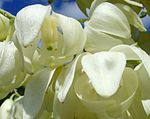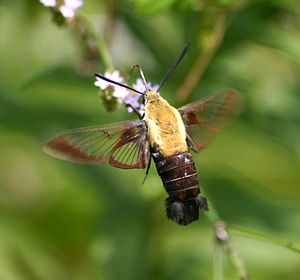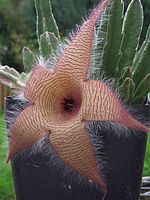- Pollination syndrome
-
 Baltimore (Euphydryas phaeton) nectaring at daisy (Argyranthemum)
Baltimore (Euphydryas phaeton) nectaring at daisy (Argyranthemum)
Pollination syndromes are suites of flower traits that have evolved in response to natural selection imposed by different pollen vectors, which can be abiotic (wind and water) or biotic, such as birds, bees, flies, and so forth.[1][2] These traits include flower shape, size, colour, odour, reward type and amount, nectar composition, timing of flowering, etc. For example, tubular red flowers with copious nectar often attract birds; foul smelling flowers attract carrion flies or beetles, etc.
The "classical" pollination syndromes as they are currently defined (see below) were developed in the 19th Century by the Italian botanist Federico Delpino. Although they have been useful in developing our understanding of plant-pollinator interactions, an uncritical acceptance of pollination syndromes as providing a framework for classifying these relationships is rather out of date.[3]
Contents
Abiotic pollination syndromes
These do not attract animal pollinators. Nevertheless, they often have suites of shared traits.
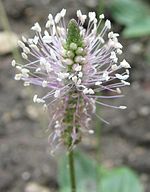 Plantago media, pollinated by wind or insects
Plantago media, pollinated by wind or insects
Wind pollination (anemophily)
Flowers may be small and inconspicuous, green and not showy. They produce enormous numbers of relatively small pollen grains (hence wind-pollinated plants may be allergens, but seldom are animal-pollinated plants allergenic). Their stigmas may be large and feathery to catch the pollen grains. Insects may visit them to collect pollen; in some cases these are ineffective pollinators and exert little natural selection on the flowers, but there are also examples of ambophilous flowers which are both wind and insect pollinated. Anaemophilous or wind pollinated flowers should be usually small,inconspicuos.uattractive.They do not produce scent or nectar but the anther produce a large number of pollen grains,the stamens are long and protrude out of flower.
Water pollination (hydrophily)
Water-pollinated plants are aquatic and pollen is released into the water. Water currents therefore act as a pollen vector in a similar way to wind currents. Their flowers tend to be small and inconspicuous with lots of pollen grains and large, feathery stigmas to catch the pollen. However, this is relatively uncommon (only 2% of pollination is Hydrophily) and most aquatic plants are insect-pollinated, with flowers that emerge into the air.
Biotic pollination syndromes
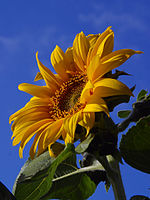 Sunflower pollinated by butterflies and bees
Sunflower pollinated by butterflies and bees
Bee pollination (melittophily)
Bee-pollinated flowers can be very variable in their size, shape and colouration. They can be open and bowl-shaped (radially symmetrical) or more complex and non-radially symmetric ("zygomorphic") such as many peas, foxgloves, etc.
Some bee flowers tend to be yellow or blue, often with ultraviolet nectar guides and scent. Nectar, pollen, or both are offered as rewards in varying amounts. The sugar in the nectar tends to be sucrose-dominated.
There are diverse types of bees, however. Honeybees, bumblebees, orchid bees, etc. are large groups that are quite distinctive in size, tongue length and behaviour (some solitary, some colonial). Thus generalization about bees is difficult.[4] Some plants can only be pollinated by bees because their anthers release pollen internally, and it must be shaken out by buzz pollination (also known as "sonication"). Bees are the only animals that perform this behaviour. Bumblebees sonicate, but honeybees do not.
Bee pollination from mobile beehives is of great economic value for orchards such as apple or almond.
Wasp pollination
Wasps are also responsible for the pollination of several plants species, being important pollen vectors and, in some cases, efficient pollinators even more than bees.[5]
Butterfly pollination (psychophily)
Butterfly-pollinated flowers tend to be large and showy, pink or lavender in colour, frequently have a landing area, and are usually scented. Since butterflies do not digest pollen (with one exception), more nectar is offered than pollen. The flowers have simple nectar guides with the nectaries usually hidden in narrow tubes or spurs, reached by the long tongue of the butterflies.
Hesperoyucca whipplei (moth-pollinated)
Moth pollination (phalaenophily)
Among the more important moth pollinators are the hawk moths (Sphingidae). Their behaviour is similar to hummingbirds: they hover in front of flowers with rapid wingbeats. Most are nocturnal or crepuscular. So moth-pollinated flowers tend to be white, night-opening, large and showy with tubular corollas and a strong, sweet scent produced in the evening, night or early morning. A lot of nectar is produced to fuel the high metabolic rates needed to power their flight.
Other moths (Noctuids, Geometrids, Pyralids, for example) fly slowly and settle on the flower. They do not require as much nectar as the fast-flying hawk moths, and the flowers tend to be small (though they may be aggregated in heads).[6]
Fly pollination (myophily and sapromyophily)
The classical syndromes recognise two types of fly pollination: myophily and sapromyophily. Some flies feed on nectar and pollen as adults (particularly bee flies (Bombyliidae), hoverflies (Syrphidae), etc.). Those regularly visit flowers. On the other hand, male fruit flies (Tephritidae) are attracted to and feed on specific floral attractant, which acts as fly's sex pheromone precursor or booster, of some wild orchids (Bulbophyllum species - with highly moveable lip) that do not produce nectar.[7][8] These are the myophiles. Sapromyophiles, on the other hand, normally visit dead animals or dung. They are attracted to flowers that mimic these odoriferous items. They obtain no reward and would quickly leave, but the plant may have traps to slow them down. These plants have a strong, unpleasant odor, and are brown or orange in color. They are not as common as myophilous plants.[9] Myophilous plants do not tend to have a strong scent, and tend to be purple, violet, blue, and white, open dishes, or tubes.[10] Although they have traditionally been considered to be ineffective and unreliable pollinators, their sheer numbers and the presence of some flies throughout the year make them important pollinators for many plants.[11]
Flies tend to be important pollinators in high-altitude and high-latitude systems, where they are numerous and other insect groups may be lacking.[12]
Bird pollination (ornithophily)
Although hummingbirds are the most familiar nectar-feeding birds for North Americans, there are analogous species in other parts of the world: sunbirds, honeyeaters, flowerpeckers, honeycreepers, bananaquits, flowerpiercers, lories and lorikeets.[13] Hummingbirds are the oldest group, with the greatest degree of specialization on nectar.[13] Flowers attractive to hummingbirds that can hover in front of the flower tend to be large red or orange tubes with a lot of dilute nectar, secreted during the day. Since birds do not have a strong response to scent, they tend to be odorless. Perching birds need a substantial landing platform, so sunbirds, honeyeaters, and the like are less associated with tubular flowers.
Bat pollination (chiropterophily)
Bat-pollinated flowers tend to be large and showy, white or light coloured, open at night and have strong odours. They are often large and bell-shaped. Bats drink the nectar, and these plants typically offer nectar for extended periods of time. Sight, smell, and echo-location are used to initially find the flowers, and excellent spatial memory is used to visit them repeatedly.[14] In fact, bats can identify nectar-producing flowers using echolocation.[14] In the New World, bat pollinated flowers often have sulfur-scented compounds, but this does not carry to other parts of the world.[15] Bat-pollinated plants have bigger pollen than their relatives.[16]
Beetle pollination (cantharophily)
Beetle-pollinated flowers are usually large, greenish or off-white in color and heavily scented. Scents may be spicy, fruity, or similar to decaying organic material. Most beetle-pollinated flowers are flattened or dish shaped, with pollen easily accessible, although they may include traps to keep the beetle longer. The plant's ovaries are usually well protected from the biting mouthparts of their pollinators.[11] Beetles may be particularly important in some parts of the world such as semi-arid areas of southern Africa and southern California[17] and the montane grasslands of KwaZulu-Natal in South Africa.[18]
Biology
Pollination syndromes reflect convergent evolution towards forms (phenotypes) that limit the number of species of pollinators visiting the plant.[4] They increase the functional specialization of the plant with regard to pollination, though this may not affect the ecological specialization (i.e. the number of species of pollinators within that functional group).[19] They are responses to common selection pressures exerted by shared pollinators or abiotic pollen vectors, which generate correlations among traits. That is, if two distantly related plant species are both pollinated by nocturnal moths, for example, their flowers will converge on a form which is recognised by the moths (e.g. pale colour, sweet scent, nectar released at the base of a long tube, night-flowering).
Advantages of specialization
- Efficiency of pollination: the rewards given to pollinators (commonly nectar or pollen or both, but sometimes oil,[20] scents, resins, or wax) may be costly to produce. Nectar can be cheap, but pollen is generally expensive as it is relatively high in nitrogen compounds. Plants have evolved to obtain the maximum pollen transfer for the minimum reward. Different pollinators, because of their size, shape, or behaviour, have different efficiencies of transfer of pollen. And the floral traits affect efficiency of transfer: columbine flowers were experimentally altered and presented to hawkmoths, and flower orientation, shape, and colour were found to affect visitation rates or pollen removal.[21][22]
- Pollinator Constancy: to efficiently transfer pollen, it is best for the plant if the pollinator focuses on one species of plant, ignoring other species. Otherwise, pollen may be dropped uselessly on the stigmas of other species. Animals, of course, do not aim to pollinate, they aim to collect food as fast as they can. However, many pollinator species exhibit constancy, passing up available flowers to focus on one plant species. Why should animals specialize on a plant species, rather than move to the next flower of any species? Although pollinator constancy was recognized by Aristotle, the benefits to animals are not yet fully understood.[23] The most common hypothesis is that pollinators must learn to handle particular types of flowers, and they have limited capacity to learn different types. They can only efficiently gather rewards from one type of flower.
Pollinator constancy: these honeybees selectively visit flowers from only one species, as can be seen by the colour of the pollen in their baskets:
Advantages of generalization
Pollinators fluctuate in abundance and activity independently of their plants,[19][24] and any one species may fail to pollinate a plant in a particular year. Thus a plant may be at an advantage if it attracts several species or types of pollinators, ensuring pollen transfer every year.[25] Plants do, in many species, have the back-up option of self-pollination, if they are not self-incompatible.
Criticisms of the syndromes
Whilst it is clear that pollination syndromes can be observed in nature, there has been much debate amongst scientists as to how frequent they are and to what extent we can use the classical syndromes to classify plant-pollinator interactions.[26] Although some species of plants are visited only by one type of animal (i.e. they are functionally specialized), many plant species are visited by very different pollinators.[25][27] For example, a flower may be pollinated by bees, butterflies, and birds. Strict specialization of plants relying on one species of pollinator is relatively rare, probably because it can result in variable reproductive success across years as pollinator populations vary significantly.[25] In such cases, plants should generalize on a wide range of pollinators, and such ecological generalization is frequently found in nature. A study in Tasmania found the syndromes did not usefully predict the pollinators.[28]
This debate has led to a critical re-evaluation of the syndromes, which suggests that on average about one third of the flowering plants can be classified into the classical syndromes.[3] This reflects the fact that nature is much less predictable and straightforward than 19th Century biologists originally thought. Pollination syndromes can be thought of as extremes of a continuum of greater or lesser specialization or generalization onto particular functional groups of pollinators that exert similar selective pressures”[4] and the frequency with which flowers conform to the expectations of the pollination syndromes is relatively rare. In addition, new types of plant-pollinator interaction, involving "unusual" pollinating animals are regularly being discovered, such as specialized pollination by spider hunting wasps (Pompilidae) and fruit chafers (Cetoniidae) in the eastern grasslands of South Africa.[18] These plants do not fit into the classical syndromes, though they may show evidence of convergent evolution in their own right.
An analysis of flower traits and visitation in 49 species in the plant genus Penstemon found that it was possible to separate bird- and bee- pollinated species quite well, but only by using floral traits which were not considered in the classical accounts of syndromes, such as the details of anther opening.[29] Although a recent review concluded that there is “overwhelming evidence that functional groups exert different selection pressures on floral traits”,[4] the sheer complexity and subtlety of plant-pollinator interactions (and the growing recognition that non-pollinating organisms such as seed predators can affect the evolution of flower traits) means that this debate is likely to continue for some time.
See also
References
- ^ Fægri, K. and van der Pijl, L. (1979) The principles of pollination ecology. Pergamon Press, Oxford
- ^ Proctor M , P. Yeo, and A. Lack (1996). The natural history of pollination. HarperCollins, London.. ISBN 0881923524.
- ^ a b Ollerton, J., Alarcón, R., Waser, N.M., Price, M.V., Watts, S., Cranmer, L., Hingston, A. Peter, C.I. and Rotenberry, J. (2009) A global test of the pollination syndrome hypothesis. Annals of Botany doi:10.1093/aob/mcp031
- ^ a b c d Fenster, CB, WS Armbruster, P Wilson, MR Dudash, and JD Thomson (2004). "Pollination syndromes and floral specialization". Annual Review of Ecology and Systematics 35 (1): 375–403. doi:10.1146/annurev.ecolsys.34.011802.132347.
- ^ Sühs, R.B.; Somavilla, A.; Putzke, J.; Köhler, A. 2009. Pollen vector wasps (Hymenoptera, Vespidae) of Schinus terebinthifolius Raddi (Anacardiaceae), Santa Cruz do Sul, RS, Brazil. Brazilian Journal of Biosciences 7, n. 2, p. 138-143. Link: http://www.ufrgs.br/seerbio/ojs/index.php/rbb/article/view/1123
- ^ Oliveira PE, PE Gibbs, and AA Barbosa (2004). "Moth pollination of woody species in the Cerrados of Central Brazil: a case of so much owed to so few?". Plant Systematics and Evolution 245 (1-2): 41–54. doi:10.1007/s00606-003-0120-0.
- ^ Tan, KH and R Nishida (2000). "Mutual reproductive benefits between a wild orchid, Bulbophyllum patens, and Bactrocera fruit flies via a floral synomone.". Journal of Chemical Ecology 26 (2): 533–546. doi:10.1023/A:1005477926244.
- ^ Tan, KH, LT Tan and R Nishida (2006). "Floral phenylpropanoid cocktail and architecture of Bulbophyllum vinaceum orchid in attracting fruit flies for pollination.". Journal of Chemical Ecology 32 (11): 2429–2441. doi:10.1007/s10886-006-9154-4. PMID 17082990.
- ^ Jones, GD and SD Jones (2001). "The uses of pollen and its implication for Entomology". Neotropical Entomology 30 (3): 314–349. doi:10.1590/S1519-566X2001000300001.
- ^ Kastinger C, and A Weber (2001). "Bee-flies (Bombylius spp., Bombyliidae, Diptera) and the pollination of flowers". Flora 196 (1): 3–25.
- ^ a b P.J. Gullan and P.S. Cranston (2005). The Insects: An Outline of Entomology. Blackwell Publishing Ltd. p. 282. ISBN 1-4051-1113-5.
- ^ Larson BMH, PG Kevan, and DW Inouye (2001). "Flies and flowers: taxonomic diversity of anthophiles and pollinators". Canadian Entomologist 133 (4): 439–465. doi:10.4039/Ent133439-4.
- ^ a b Lotz, CN and JE Schondube (2006). "Sugar Preferences in Nectar- and Fruit-Eating Birds: Behavioral Patterns and Physiological Causes". Biotropica 38 (1): 3–15.
- ^ a b Von Helversen D, MW Holderied, and O Von Helversen (2003). "Echoes of bat-pollinated bell-shaped flowers: conspicuous for nectar-feeding bats?" (abstract page). Journal of Experimental Biology 206 (6): 1025–1034. doi:10.1242/jeb.00203. PMID 12582145. http://jeb.biologists.org/cgi/content/abstract/206/6/1025.
- ^ Pettersson S, F Ervik, and JT Knudsen (2004). "Floral scent of bat-pollinated species: West Africa vs. the New World". Biological Journal of the Linnean Society 82 (2): 161–168. doi:10.1111/j.1095-8312.2004.00317.x. http://www.blackwell-synergy.com/links/doi/10.1111%2Fj.1095-8312.2004.00317.x.
- ^ Stroo, A. (2000). "Pollen morphological evolution in bat pollinated plants". Plant Systematics and Evolution 222 (1-4): 225–242. doi:10.1007/BF00984104.
- ^ Jones, GD and SD Jones (2001). "The uses of pollen and its implication for Entomology". Neotropical Entomology 30 (3): 314–349. doi:10.1590/S1519-566X2001000300001
- ^ a b Ollerton J., Johnson S. D., Cranmer, L. and Kellie, S. (2003) The pollination ecology of an assemblage of grassland asclepiads in South Africa. Annals of Botany 92: 807-834.
- ^ a b Ollerton,J., Killick, A., Lamborn, E., Watts, S. & Whiston, M. (2007) Multiple meanings and modes: on the many ways to be a generalist flower. Taxon 56: 717-728
- ^ Buchmann, SL. (1987). "The ecology of oil flowers and their bees". Annual Review of Ecology and Systematics 18 (1): 343–70. doi:10.1146/annurev.es.18.110187.002015.
- ^ Fulton M and Hodges SA (1999). "Floral isolation between Aquilegia formosa and A. pubescens.". Proceedings of the Royal Society of London, Series B 266 (1435): 2247–2252. doi:10.1098/rspb.1999.0915.
- ^ Hodges SA, JB Whittall, M Fulton, and JY Yang (2002). "Genetics of floral traits influencing reproductive isolation between Aquilegia formosa and A. pubescens". American Naturalist 159 (s3): S51–S60. doi:10.1086/338372. PMID 18707369.
- ^ Gegear, RJ and TM Laverty (2005). "Flower constancy in bumblebees: a test of the trait variability hypothesis". Animal Behaviour 69 (4): 939–949. doi:10.1016/j.anbehav.2004.06.029.
- ^ Pettersson MW (1991). "Pollination by a guild of fluctuating moth populations: option for unspecialization in Silene vulgaris". Journal of Ecology (British Ecological Society) 79 (3): 591–604. doi:10.2307/2260655. JSTOR 2260655.
- ^ a b c Waser, NM, L Chittka, MV Price, NM Williams and J. Ollerton (1996). "Generalization in pollination systems, and why it matters". Ecology (Ecological Society of America) 77 (4): 1043–1060. doi:10.2307/2265575. JSTOR 2265575.
- ^ Ollerton, J. (1998) Sunbird surprise for syndromes. Nature 394: 726-727
- ^ Herrera, CM (1996). "Floral traits and adaptation to insect pollinators: a devil’s advocate approach". In DG Lloyd & SCH Barrett. Floral Biology. Chapman & Hall, New York. pp. 65–87.
- ^ Hingston, AB and PB Mcquillan (2000). "Are pollination syndromes useful predictors of floral visitors in Tasmania?". Australian Journal of Ecology 25 (6): 600–609. doi:10.1046/j.1442-9993.2000.01059.x.
- ^ Wilson, P, M Castellanos, JN Hogue, JD Thomson and WS Armbruster (2004). "A multivariate search for pollination syndromes among penstemons.". Oikos 104 (2): 345–361. doi:10.1111/j.0030-1299.2004.12819.x.
Categories:
Wikimedia Foundation. 2010.

